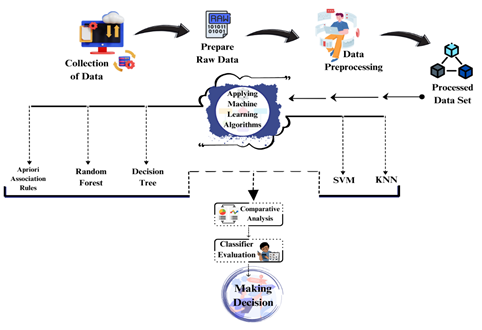Unveiling the Secrets of Obesity with Machine Learning (ML) Techniques/Algorithms
Abstract
 Abstract Views: 0
Abstract Views: 0
Obesity is the most significant health threat all over the world as it is considered the mother of all diseases. Recent decades have witnessed an extensive shift towards sedentary lifestyles including adaptation to luxury modes of transportation, processed food, lack of physical activities, and prolonged screen times. The trend of using cars and motorcycles to travel even short distances has emerged as a critical component in Pakistan's obesity pandemic. Whenever the causes of obesity are discussed, the focus remains always on processed food and genetic factors. This study is an effort to exploit a machine-learning-based pathway to predict the major causes of obesity using machine learning (ML) algorithms. For this research, a dataset of 2,111 instances of various age groups and lifestyles was employed. For analysis, three efficient ML algorithms known as k-nearest neighbor (k-NN or KNN), support vector machine (SVM), and decision tree (DT) were utilized. It was observed that the excessive use of personal transport and comparatively limited availability and use of public transport has been a significant cause of obesity in Class II and III obese individuals. From the experimental results, strong association rules with minimum confidence value of 25% and maximum support value of 80% were obtained. Also, DT with random forest technique was found to have the highest accuracy of 90.36%, with the recall factor value of 98.73%. This signifies the fact that sedentary lifestyle and mode of transportation have a significant impact on rising obesity level.
Downloads

Copyright (c) 2024 Abdur Rauf, Muhammad Ammar, Mahnoor Azhar, Nasreen Noor, Syeda Marriam Bakhtiar

This work is licensed under a Creative Commons Attribution 4.0 International License.
Author(s) retain copyright and grant the journal right of first publication with the work simultaneously licensed under a Creative Commons Attribution (CC-BY) 4.0 License that allows others to share the work with an acknowledgment of the work’s authorship and initial publication in this journal.






